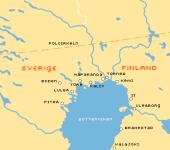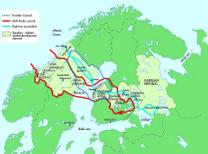|
|
|
3.1 Cross-border co-operation for regional development
VASAB project
The emergence of new independent States in CEEC has in some cases interrupted long-established ties at local levels, in fields such as culture, education, tourism, environment protection, or labour markets.
This led to the search for possibilities to revive such ties, under changed conditions, across borders to the mutual benefit. A similar issue arises at borders which continued to exist, but which have become open for more intensive interchange.
VASAB project:
Cross-border co-operation for regional development
The border region in the triangle Latvia/ Lithuania/ Belarus was chosen as a case. This is a typical example for new border regions, where the interruption of strong linkages and the emergence of new barriers adds to the problems of structural change in the transition process.
A fact-finding phase concentrated at the involvement of local and regional actors from this border area. Intensive dialogues led to a number of ideas for joint cross-border co-operation for development.
This approach was highly welcomed by local actors. Funding limitations hindered to proceed to the next stage of concrete action preparation.
InterregIIC projects on transnational regional development co-operation
Several Interreg II C projects have adopted an even wider approach towards transnational regional development co-operation.
InterregIIC project:
STRING
This project covers the south-western Baltic Sea transregional corridor area Hamburg - Kiel/ Lübeck - Copenhagen - Malmö. STRING involves politicians at a high level.
STRING is a broad project to create a platform for developing joint strategies and networks. These shall help to meet common economic, environmental, social and spatial potentials and challenges in the co-operation area.
Though transport infrastructure improvement (fixed link across the Fehmarn Belt) is considered essential to achieve cohesion, the project has a broader view, dealing with business development in the 'new economy', enhancing mobility of people in a learning society, promoting cultural identity, knowledge exchange, sustainable settlement structures, landscape and nature protection.
|
The STRING Area
|

|
Cross-border regional
development co-operation
Conclusions
The VASAB approach is relevant for various parts of the BSR. This is underlined by the high number of InterregIIC projects in this field.
These projects have widened the VASAB approach to consider integrated development of transport infrastructure, culture, economy, institutions, and environment in a cross-sector perspective.
Present projects concentrate on already strong regions. Transborder co-operation to strengthen weaker regions needs to be enhanced.
|
InterregIIC project:
Baltic Bridge
Baltic Bridge covers the area of Brandenburg (Germany), Western Pomerania and Szczecin (Poland), and Skåne (Sweden). It aims at
- improved transport systems
- urban networking
- strengthening of rural areas
- tri-national regional development management structures.
It is, hence, an approach which integrates transport infrastructure with overall regional development.
BOTHNIAN ARC
|
The Bothnian Arc Area
|

|
InterregIIC project:
This is an umbrella project for cross-border regional development co-operation between Sweden and Finland in the region surrounding the Gulf of Bothnia. It considers a vast hinterland in the northernmost parts of Sweden, Finland, Norway and North West Russia. It comprises three sub-projects: (a) Vision, Strategy and Network; (b) Communication Systems, and (c) Tourism and Environment. - InterregIIC project:
KASPNET
|
The KASPNET region
|

|
The KASPNET (Karelian-Atlantic Spatial Planning Development network) area ranges from Norway through Sweden and Finland to the Karelian Republic.
The project analyses regional development potentials, conducts thematic studies, exchange of knowledge and develops, based on a code of best practice, a spatial strategy. A main purpose is to establish improved co-operation networks, and to identify key investment projects.
|
|
|

